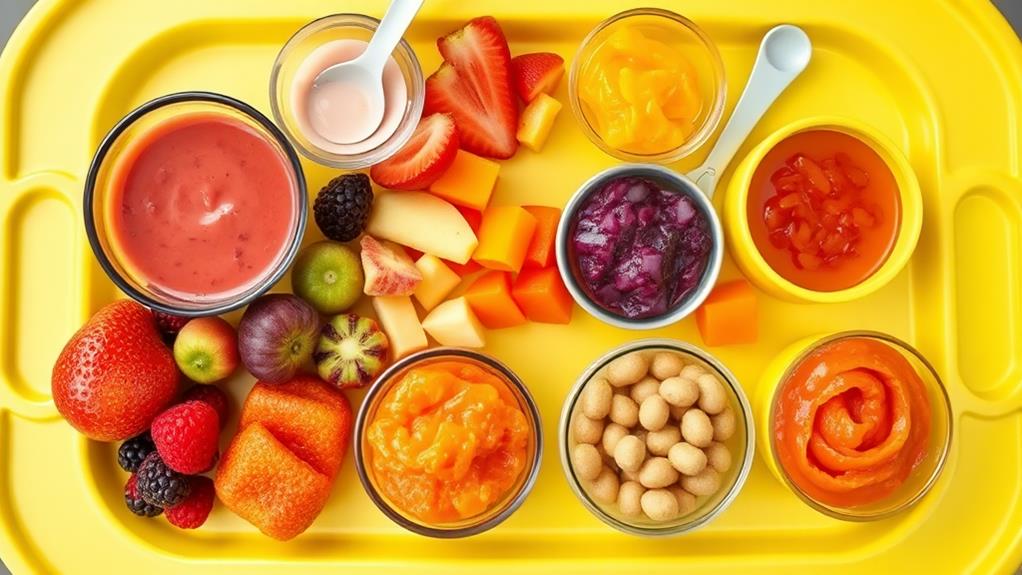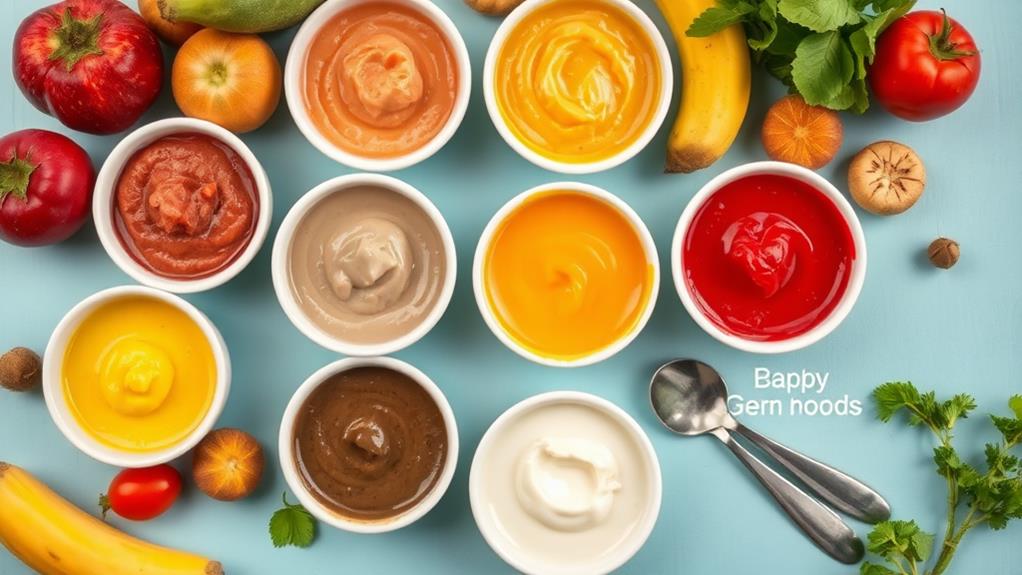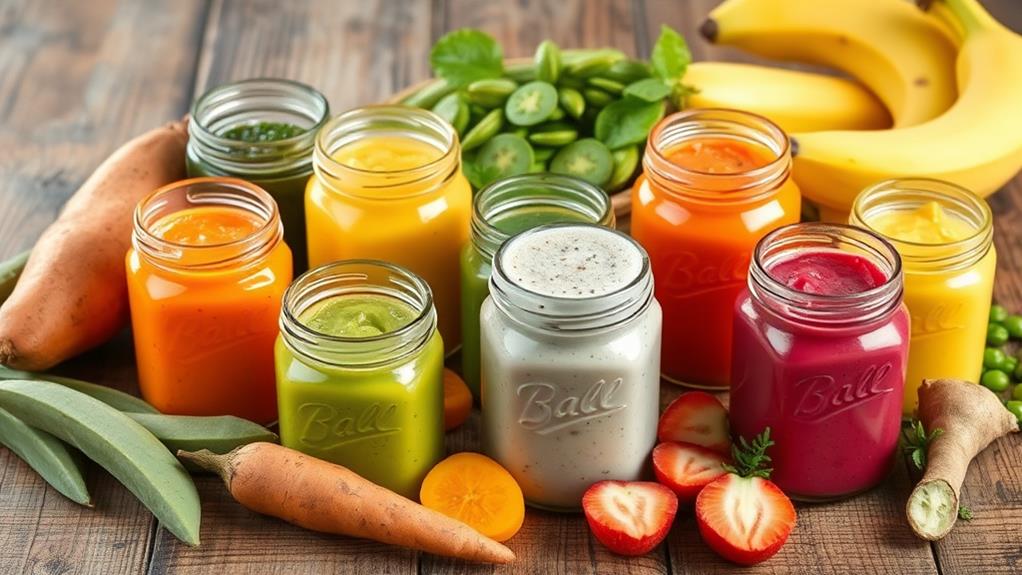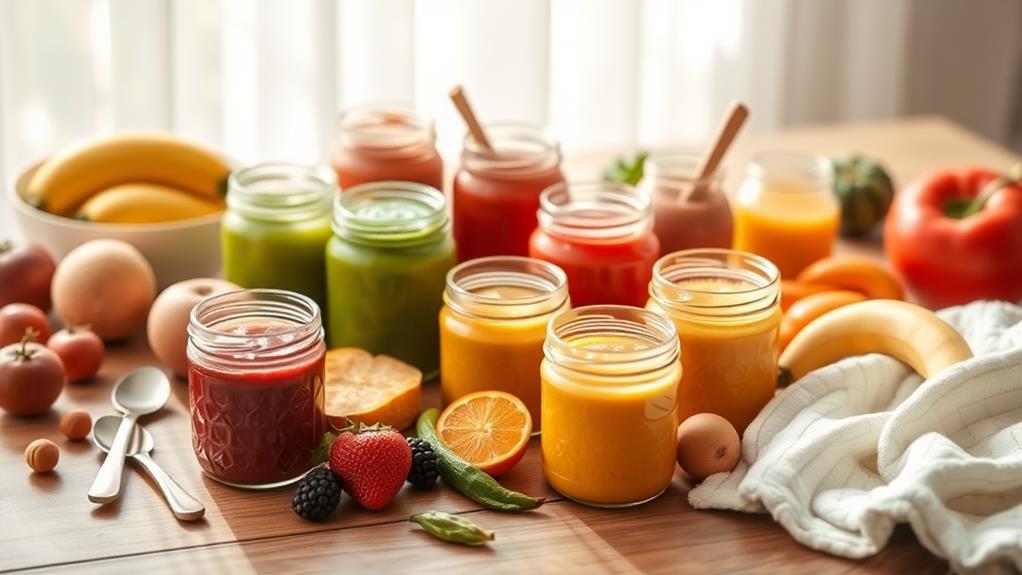As your baby reaches the 8-month mark, it's essential to establish a balanced food schedule that introduces a variety of flavors and textures. You'll want to ensure they're getting enough iron and nutrients, which means incorporating pureed meats, fruits, and vegetables into their meals. While you might already have some ideas, there are specific signs to look for when introducing new foods and transitioning from purees to finger foods. Understanding this progression can make a significant difference in their eating habits, and you might be surprised by the simple yet nutritious recipes that can enhance their diet.
Nutritional Guidelines for 8-Month-Olds

When it comes to your baby's nutritional needs at 8 months, it's crucial to ensure they're getting the right balance of nutrients. At this age, your little one typically needs about 24-32 ounces of breast milk or formula daily, along with two solid meals—this can increase to three meals as they become more curious about food.
Iron-rich foods are super important now since your baby's iron stores are starting to dip. Think pureed meats and fortified cereals to help keep those levels up! Aim for 4-9 tablespoons of cereals, fruits, and veggies, plus 1-6 tablespoons of protein sources. It's all about balance!
Don't forget to mix up the textures, too. Offering thicker purees and soft finger foods encourages chewing skills and helps your baby accept different food types.
When feeding, keep an eye out for any signs of food allergies. Introduce new foods one at a time and wait around 3-5 days before adding something new to the meal plan. This way, if there's a reaction, you'll know what caused it.
Happy feeding! Your baby's taste buds are in for a fun adventure!
Signs Your Baby Is Ready
Recognizing the signs your baby is ready for solid foods can make the transition smoother and more enjoyable for both of you. Generally, babies are ready around 6 months of age, but some may show signs as early as 4 months.
Look for key signs of readiness, like your little one sitting up with minimal support, reaching for food, or moving food to the back of their mouth. It's important to check with your pediatrician to ensure they're meeting those developmental milestones before you start introducing solid foods.
As your baby's stored iron decreases, introducing iron-rich foods becomes essential for their brain development during this stage.
You'll also notice your baby's interest in eating—watching you closely at mealtimes or trying to grab your plate. Don't be surprised if they make funny faces at new flavors; those food reactions are totally normal!
Just remember, they might need several tries to accept unfamiliar textures. Aim for a couple of solid meals a day, alongside breast milk and/or formula, to help them thrive in their first year. Happy feeding!
Introducing New Foods

As you start introducing new foods to your baby, it's crucial to take it one step at a time. Begin with single-ingredient first foods, like pureed carrots or apples, and wait 3-5 days before adding another new food. This way, you can monitor for allergic reactions, which is important. Some normal reactions include funny faces and unexpected messes—don't worry; it's part of the process!
As your little one gets used to eating solid foods, you'll want to gradually progress from pureed foods to lumpy and finely chopped textures. A food processor can be your best friend here, helping you create the right consistency.
Just remember to avoid honey until your baby is over 12 months old, as it can lead to botulism.
Also, be careful with common allergenic foods like eggs, peanuts, fish, and wheat. It's a good idea to consult with your pediatrician before introducing these items.
Always ensure that foods are appropriately prepared to minimize choking hazards, and keep your feeding schedule flexible. With patience and love, your baby will be on their way to enjoying a variety of flavors!
Sample Feeding Schedule
After you've introduced new foods and your baby is getting accustomed to solids, it's important to establish a feeding schedule that fits their growing needs.
For your little one who's 4 to 6 months old, try starting with 1-4 tablespoons of infant cereal or pureed fruits and vegetables once or twice daily, while still providing 24-36 ounces of breast milk or formula.
Once they hit 6 to 7 months, you can ramp it up to 1-2 solid meals daily, offering 4-9 tablespoons of cereals, fruits, and veggies, all while keeping the same amount of breast milk or formula.
Delicious Recipes for Baby

Creating homemade baby food can be both fun and rewarding, allowing you to introduce your little one to a range of delicious flavors and nutrients. Start with easy recipes like baked sweet potato, which makes a fantastic first food. Just bake it, mash it into a purée, and you've got a nutrient-rich treat packed with vitamins A and C!
Don't stop there—get creative! Try steaming and blending peas for a smooth pea purée or mashing ripe bananas and avocados. Both are loaded with healthy fats and essential vitamins, perfect for your growing baby.
As your little one gets used to different flavors, introduce a mix of fruits and vegetables like carrots or pumpkin to expand their palate.
For older infants, you can whip up quinoa ratatouille or creamy Provencal chicken. These delicious recipes not only provide diverse flavors but also make the transition to more complex meals easier.

